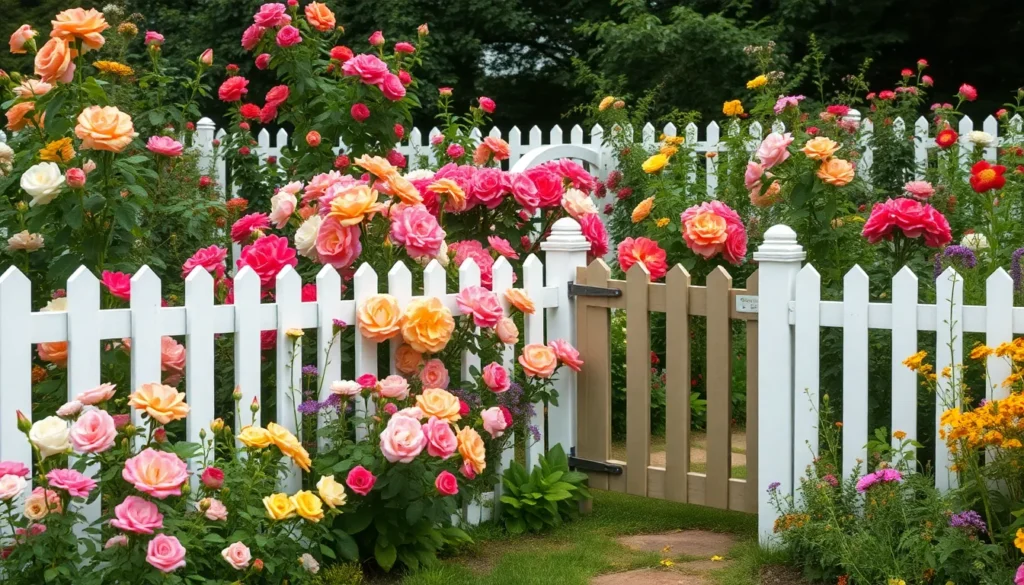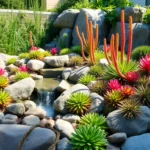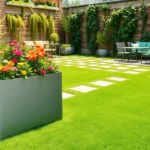We know how challenging it can be to transform your outdoor space into something truly spectacular, especially with the UK’s unpredictable weather and unique growing conditions. Whether you’re working with a compact city garden, sprawling countryside plot, or everything in between, the right design ideas can turn any space into your personal sanctuary.
British gardens have their own distinct charm and requirements that set them apart from other climates. We’ve discovered that understanding your local soil conditions, seasonal changes, and native plant varieties makes all the difference between a thriving garden and a struggling one.
From cottage garden classics to modern minimalist designs, we’ll explore practical ideas that work beautifully in the UK climate. These aren’t just pretty concepts – they’re proven strategies that help you create stunning outdoor spaces while working with nature rather than against it.
Create a Classic English Cottage Garden With Traditional Perennials
Building on our understanding of UK growing conditions, we’ll now explore how to design the quintessential English cottage garden that thrives in our climate. These gardens capture the romantic charm of rural England while supporting the diverse perennials that flourish in our unique weather patterns.
Choose Heritage Roses and Climbing Varieties
Heritage roses form the backbone of any authentic cottage garden design in the UK. We recommend selecting disease-resistant varieties like ‘Graham Thomas’, ‘Gertrude Jekyll’, and ‘The Generous Gardener’ that withstand our wet winters and variable summers. These roses offer repeat flowering throughout our growing season while maintaining the classic fragrance and form of traditional English varieties.
Climbing roses transform vertical spaces into stunning focal points when trained along pergolas, walls, and arbors. Popular choices include ‘Albertine’ for its pale pink blooms and strong scent, ‘New Dawn’ for continuous flowering, and ‘Madame Alfred Carrière’ for its tolerance of north-facing positions. Position these climbers where they’ll receive morning sun but afternoon protection from harsh weather.
Plant Mixed Herbaceous Borders
Mixed herbaceous borders create the cottage garden’s signature layered look using perennials that return year after year. We suggest combining tall plants like delphiniums, hollyhocks, and foxgloves at the back with medium-height lavender, catmint, and hardy geraniums in the middle. Low-growing plants such as lady’s mantle, sweet alyssum, and creeping thyme work perfectly along border edges.
Traditional cottage garden plants thrive in our UK soil conditions when we group them according to their water and light requirements. Moisture-loving plants like astilbe, ligularia, and rodgersia excel in our naturally damp conditions, while Mediterranean herbs including rosemary, sage, and oregano prefer well-draining spots that mimic their native habitats.
Add Picket Fencing and Garden Gates
Picket fencing defines garden boundaries while maintaining the open, welcoming feel essential to cottage garden style. We choose weathered wood or painted white pickets that complement our home’s architecture and allow climbing plants to weave through the slats. Standard picket heights range from 3 to 4 feet, providing structure without blocking garden views.
Garden gates serve as charming entry points that invite visitors into our cottage garden sanctuary. Traditional wooden gates with simple latches work best, especially when flanked by fragrant plants like honeysuckle or jasmine. Consider positioning gates to frame views of key garden features such as rose arbors, herb spirals, or ornamental vegetable patches that showcase the cottage garden’s practical beauty.
Design a Small Urban Garden With Space-Saving Solutions

Small urban spaces in the UK require smart design strategies that maximize both functionality and beauty. Space-saving garden answers transform even the tiniest courtyards and patios into lush, productive outdoor sanctuaries.
Install Vertical Planters and Living Walls
Vertical planters revolutionize how we approach limited garden space by utilizing upward dimensions rather than ground area. Living walls create stunning backdrops for small courtyards, balconies, and patios while providing practical growing space for herbs, flowers, and compact vegetables. These systems make gardens feel larger and more inviting by adding layers of greenery that draw the eye upward.
Privacy benefits emerge naturally from vertical installations, as living walls screen unsightly views and create intimate outdoor rooms. Wall-mounted planters work exceptionally well for growing culinary herbs like basil, thyme, and rosemary, keeping fresh ingredients within easy reach of the kitchen. Modular vertical systems allow us to customize plant arrangements and adapt layouts as seasons change.
Use Container Gardening for Patios
Container gardening offers unmatched flexibility for small urban spaces, allowing us to create beautiful and productive patio gardens. Hanging baskets maximize overhead space while pots and modular planters enable easy seasonal rearrangements and plant rotation. This approach suits renters perfectly, as containers move easily when relocating.
Ornamental plants thrive in decorative containers, creating focal points and color schemes that enhance patio aesthetics. Herbs and compact vegetables like cherry tomatoes, lettuce, and peppers produce fresh ingredients right outside the door. Seasonal changes become effortless when we can simply swap out containers rather than replant entire garden beds.
Drainage control improves significantly with container gardening, preventing waterlogged roots and allowing precise watering schedules. Different container sizes accommodate various plant types, from small succulents to larger flowering shrubs that anchor patio designs.
Create Multi-Level Planting Areas
Multi-level planting areas introduce visual depth and dramatically increase available growing space within small urban footprints. Raised beds, tiered planters, and shelving systems optimize sunlight exposure while improving drainage for healthier plant growth. These designs blend utility with aesthetics by incorporating seating areas and storage answers directly into planting structures.
Visual interest multiplies when we arrange plants at different heights, creating ever-changing landscapes that feel larger than their actual dimensions. Tiered systems allow us to group plants according to their light and water requirements, with sun-loving varieties positioned higher and shade-tolerant plants below. Built-in seating transforms functional planting areas into relaxing outdoor rooms.
Storage integration maximizes space efficiency by combining planting areas with practical storage for garden tools, cushions, and outdoor dining accessories. Multi-level designs accommodate various plant sizes and growth patterns, from trailing varieties that cascade over edges to upright specimens that provide vertical structure.
Build a Wildlife-Friendly Garden to Support Local Ecosystems
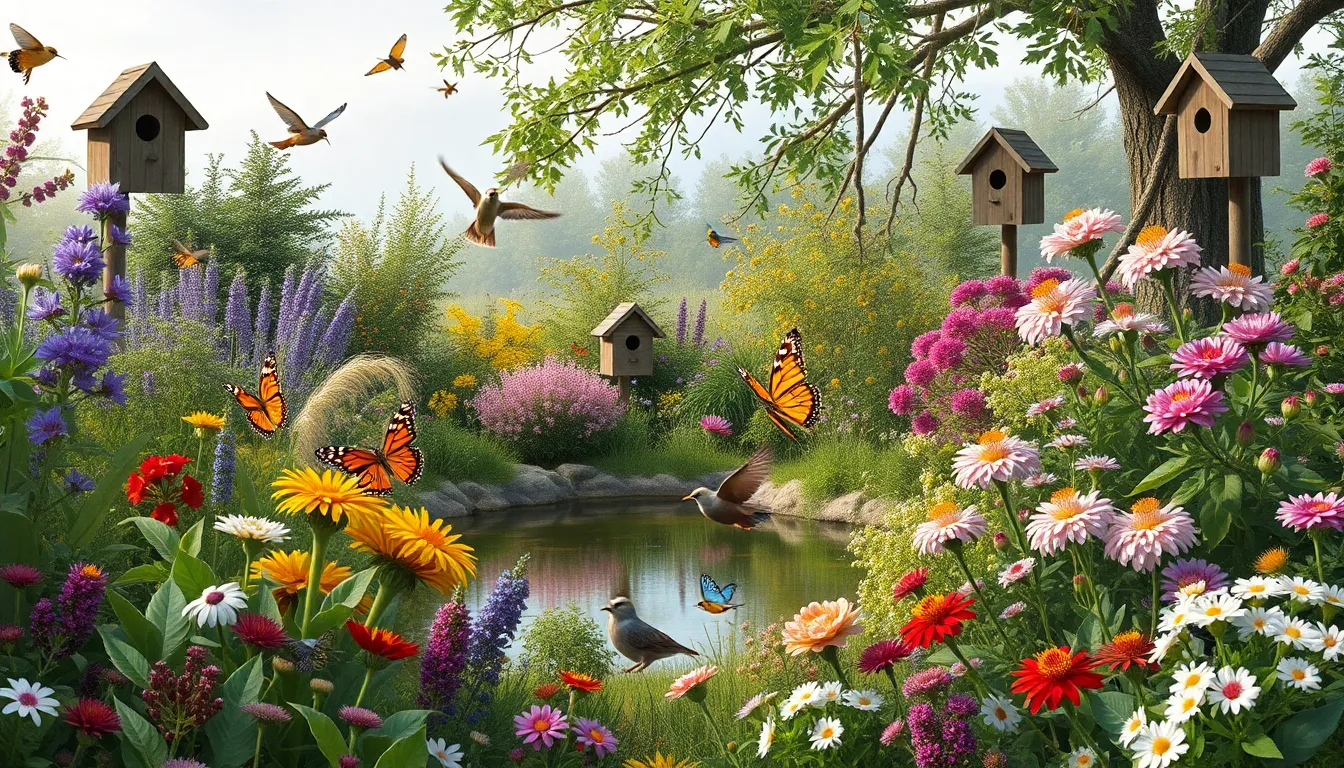
Creating a garden that welcomes local wildlife transforms our outdoor space into a thriving network that benefits both nature and our enjoyment of the garden.
Plant Native UK Flowers and Shrubs
Native plants form the foundation of any successful wildlife garden, offering essential food sources and shelter for local species. Holly provides year-round structure while producing berries that sustain birds through winter months, making it an invaluable addition to our wildlife-friendly industry. Blackthorn creates dense thickets perfect for nesting birds and produces sloe berries that attract various wildlife species.
Fruit trees such as plum and apple serve dual purposes in our garden design, offering us fresh produce while providing nectar for pollinators and fruit for birds and small mammals. Incorporating these native species ensures our garden supports the complex web of insects, birds, and other creatures that depend on familiar plant relationships.
Seasonal blooms create continuous wildlife activity throughout the year by attracting different pollinators during their active periods. Planning our flower selection to include early spring bulbs, summer perennials, and late-blooming asters maintains a steady food supply for bees, butterflies, and other beneficial insects.
Install Bird Boxes and Bee Hotels
Bird boxes provide essential nesting sites that support local bird populations struggling to find suitable homes in increasingly developed landscapes. Installing these structures at appropriate heights and orientations gives cavity-nesting species like blue tits, robins, and wrens safe places to raise their young.
Bee hotels support solitary bees and other beneficial insects by offering specialized nesting opportunities these creatures need to complete their life cycles. Different sized holes accommodate various bee species, from small mason bees to larger leafcutter bees, while the natural materials we use blend seamlessly into our garden design.
Positioning these wildlife accommodations strategically throughout our garden creates multiple habitat zones that encourage diverse species to establish residence. Placing bird boxes away from busy pathways and bee hotels in sunny, sheltered locations maximizes their effectiveness for supporting local ecosystems.
Create a Natural Pond or Water Feature
Natural ponds attract amphibians, insects, and birds while serving as vital water sources that support entire food webs in our garden network. Building a pond with shallow edges allows easy access for drinking and bathing, while deeper areas provide habitat for aquatic insects and potential breeding grounds for frogs and newts.
Water features like birdbaths or shallow dishes filled with fresh water offer simpler alternatives that still provide essential hydration for garden visitors. Regularly refreshing these water sources prevents mosquito breeding while ensuring clean drinking water remains available during dry periods.
Additional elements enhance our wildlife garden’s effectiveness through natural processes and chemical-free maintenance. Using compost enriches our soil naturally while supporting plant health without harmful fertilizers that could damage beneficial insects. Leaving piles of dead wood in shady spots provides shelter for insects and small animals, creating microhabitats that support biodiversity. Avoiding chemical pesticides protects the beneficial insects and wildlife we’re working to attract, allowing natural pest control relationships to develop in our garden network.
Establish a Kitchen Garden for Fresh Herbs and Vegetables
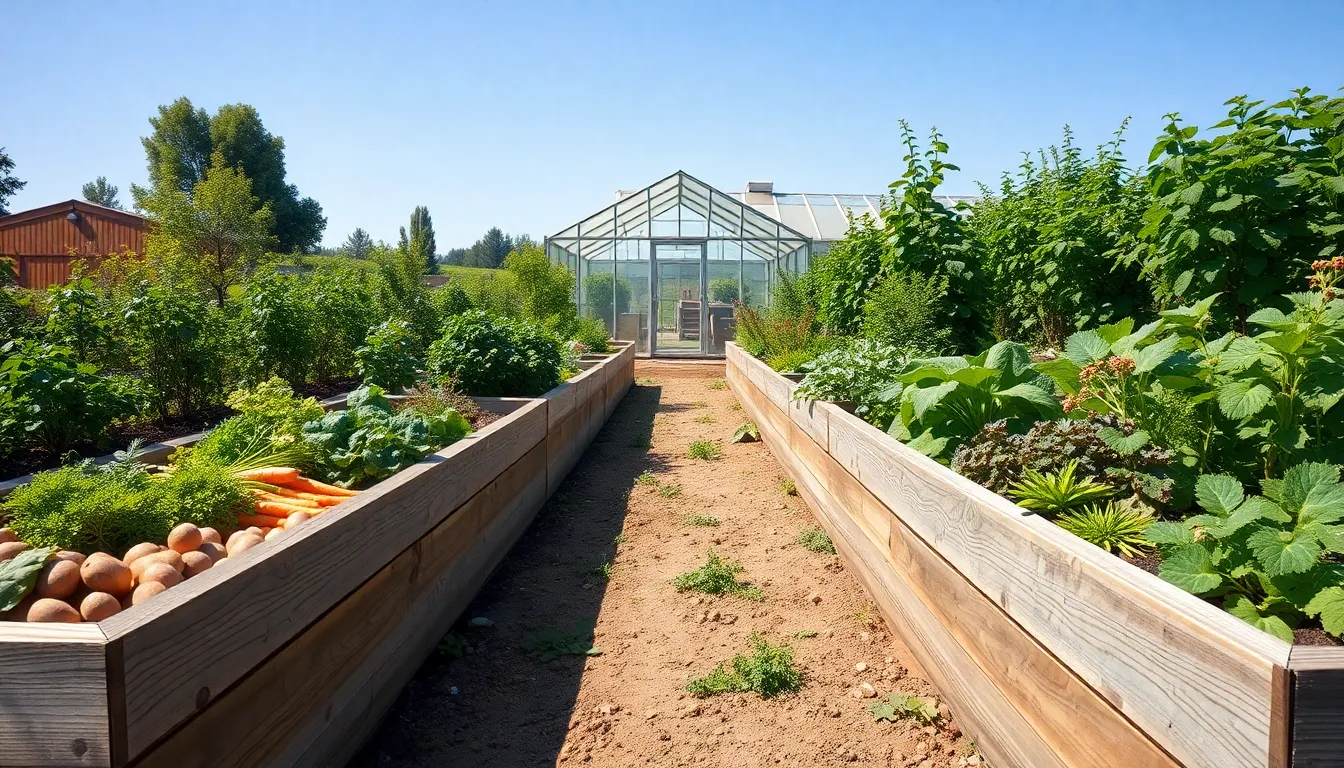
Building on our wildlife-friendly approach, we can create a productive kitchen garden that provides fresh ingredients year-round. The four-quartered design offers the most practical layout for UK gardeners, dividing our plot into rectangular beds with pathways for crop rotation.
Design Raised Beds for Easy Maintenance
Elevated planting areas transform our kitchen garden into an accessible and productive space. We’ll construct raised beds using wood, metal, or concrete materials for contemporary designs that complement our existing garden aesthetic. Better drainage naturally occurs in raised systems, preventing waterlogged soil that damages root vegetables and herbs.
Pathways between beds help easy weeding and harvesting throughout the growing season. We recommend 30 cm of quality topsoil depth for optimal root development. Organic materials like compost and manure enrich our raised bed soil, creating the foundation for abundant harvests.
Choose Cool-Weather Crops That Thrive in UK Climate
Root vegetables flourish in our temperate climate, with potatoes, carrots, and beetroot forming the backbone of any productive kitchen garden. Leafy greens like lettuce, spinach, and kale provide continuous harvests throughout cooler months. Legumes including peas and beans fix nitrogen in our soil while producing protein-rich crops.
Fresh herbs transform our cooking with minimal space requirements. Mint spreads rapidly in dedicated containers, while parsley and chives return year after year with proper care. We can mix fruit trees and flowers among our vegetables to enhance biodiversity and attract beneficial pollinators.
Add a Greenhouse or Cold Frame
Protected growing spaces extend our harvest season beyond traditional outdoor limits. Greenhouses shield tender plants from frost while maintaining optimal growing temperatures during winter months. We’ll start seeds earlier in spring and continue growing through autumn with proper protection.
Cold frames offer budget-friendly alternatives for hardening off seedlings before outdoor transplanting. These simple structures warm soil temperature and protect young plants from harsh weather conditions. Strategic placement near our kitchen ensures convenient access to fresh herbs and salad greens throughout the year.
Transform Your Front Garden Into an Attractive Welcome Space
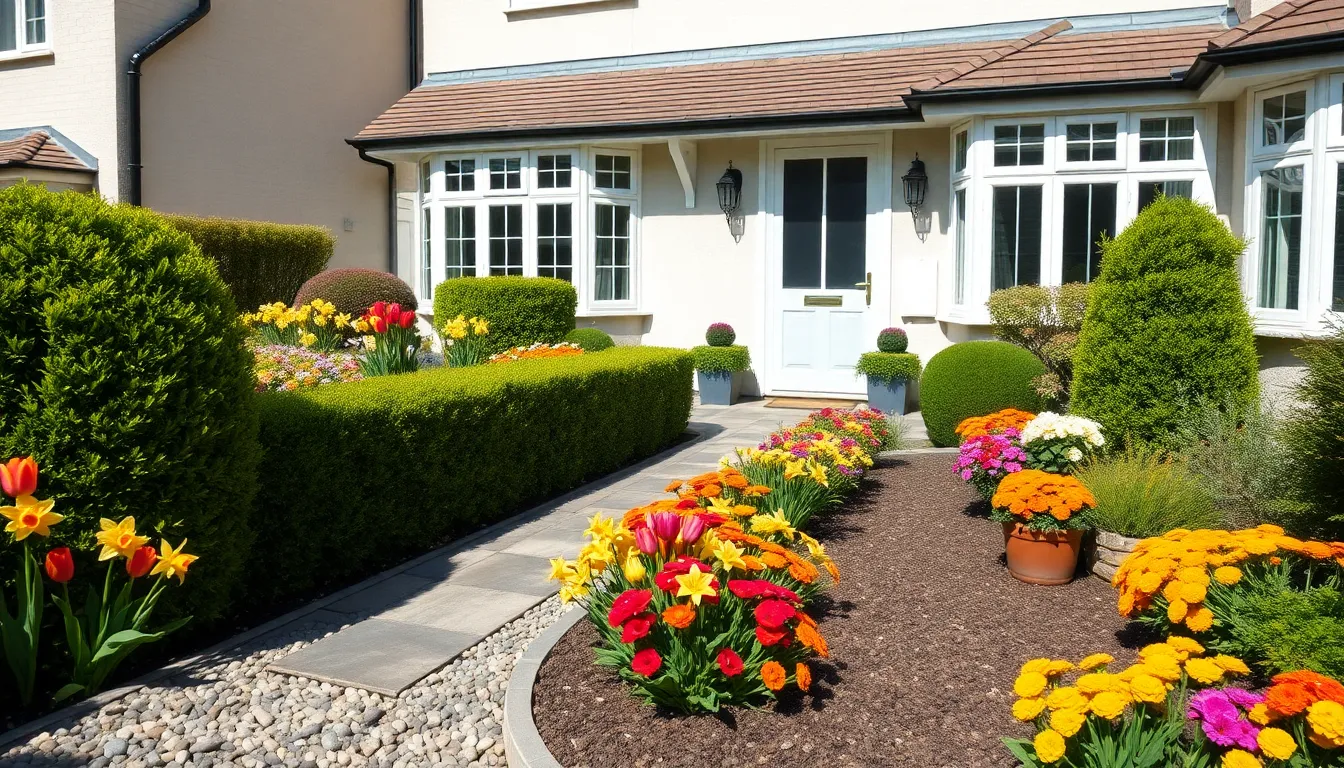
Moving from productive kitchen gardens to your home’s first impression, we’ll explore how to create an inviting front garden that welcomes visitors year round.
Use Low-Maintenance Evergreen Shrubs
Box shrubs provide exceptional year round structure with their dense, compact growth habit. These reliable evergreens require minimal watering once established and rarely need extensive pruning to maintain their shape.
Yew hedging creates formal boundaries that withstand harsh UK weather conditions. We recommend this classic choice because it tolerates both sun and shade while requiring little ongoing maintenance.
Hebes offer colorful foliage variations from silver to deep green, adding visual interest without demanding constant attention. These hardy shrubs bloom with small flowers in summer, providing subtle seasonal appeal.
Sarcococcas bring sweet winter fragrance to front gardens while thriving in challenging conditions. These compact evergreens work perfectly under windows or along pathways where their pleasant scent can be appreciated.
Create Defined Pathways With Natural Materials
Stone pathways establish elegant routes through your front garden while allowing excellent drainage. We suggest using local stone varieties that complement your home’s architecture and withstand frequent foot traffic.
Pebble walkways provide cost effective answers that reduce environmental impact compared to concrete alternatives. These permeable surfaces allow rainwater to filter naturally into the soil below.
Permeable paving combines durability with environmental responsibility, preventing water runoff issues common in urban areas. We find this material particularly useful for wider front garden paths that need to accommodate multiple visitors.
Natural material combinations work beautifully together, such as stone edging with pebble centers or permeable pavers with planted joints.
Add Seasonal Color With Bulbs and Annuals
Tulip plantings deliver spectacular spring displays in bold colors like red, purple, and yellow. We plant these bulbs in autumn for reliable blooms that coincide with longer daylight hours.
Daffodil clusters naturalize easily in UK gardens, returning stronger each year with minimal intervention. These cheerful yellow and white flowers signal winter’s end while requiring virtually no maintenance.
Marigold borders provide continuous summer color in shades of orange, yellow, and red throughout the growing season. We appreciate their pest deterrent properties alongside their vibrant blooms.
Petunia containers offer flexibility for seasonal arrangements, allowing color changes as preferences evolve. These annual flowers bloom prolifically from late spring through first frost with regular deadheading.
Succession planting ensures color transitions seamlessly from spring bulbs through summer annuals into autumn displays.
Design a Modern Minimalist Garden With Clean Lines
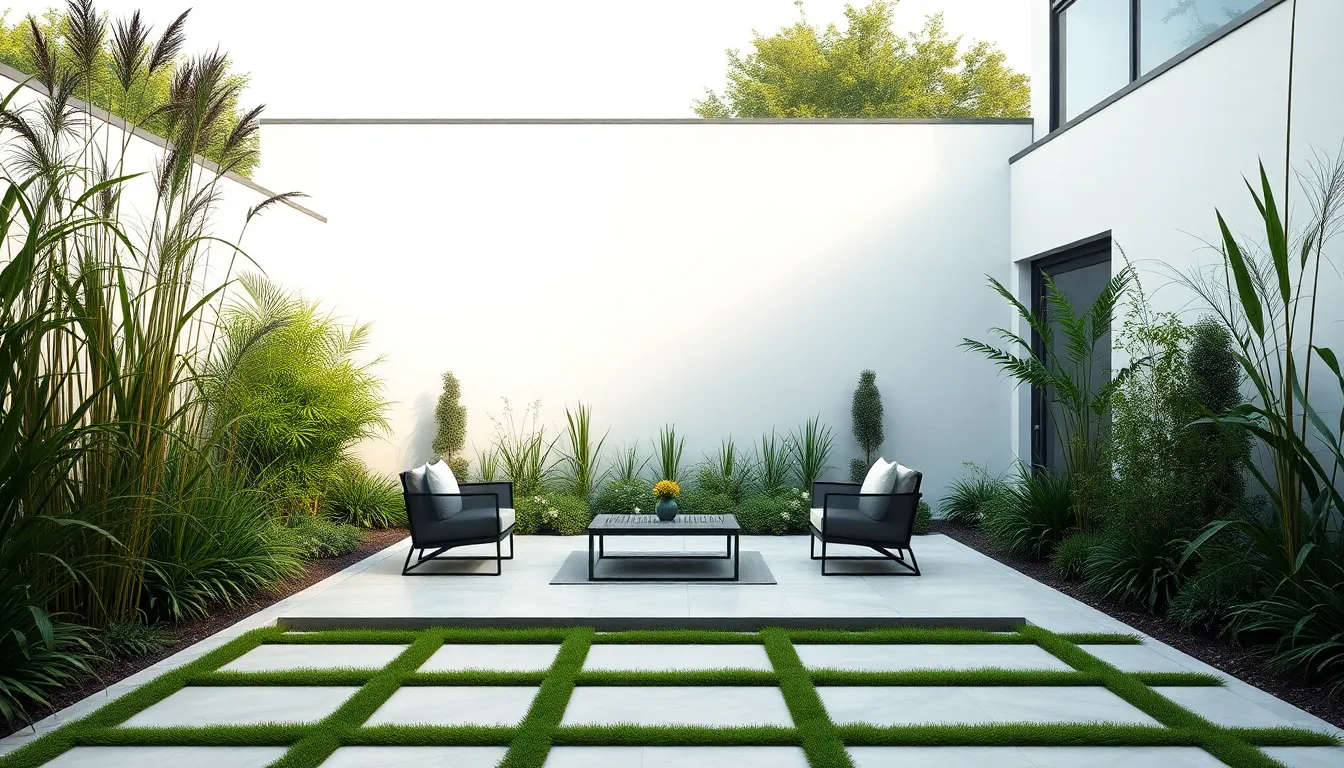
Moving from traditional cottage gardens and wildlife spaces, we can embrace the opposite end of the design spectrum with modern minimalist gardens that prioritize simplicity and tranquility. These contemporary spaces work exceptionally well in smaller UK gardens where clean lines create an immediate sense of openness.
Select Architectural Plants Like Grasses and Bamboo
Grasses provide the perfect foundation for minimalist garden design because they deliver visual interest without overwhelming small spaces. We recommend incorporating ornamental grasses like fountain grass, feather reed grass, and Japanese forest grass to create sleek architectural elements that require minimal maintenance throughout the year.
Bamboo serves as an excellent screening plant that maintains its structure across all seasons while providing natural privacy barriers. Clumping varieties like Fargesia robusta and Fargesia nitida work particularly well in UK climates, offering year-round greenery without aggressive spreading behaviors.
Structural plantings work best when grouped in odd numbers to create natural focal points that draw the eye. We suggest planting three or five specimens of the same variety together, allowing their architectural forms to make bold statements against clean backgrounds like rendered walls or steel panels.
Use Contemporary Materials Like Steel and Concrete
Steel elements introduce industrial sophistication to modern gardens through features like sleek pergolas, contemporary planters, and sculptural water features. Corten steel develops attractive rust patinas over time, creating warm orange-brown surfaces that complement both evergreen foliage and seasonal plantings.
Concrete pathways and walls establish the backbone of minimalist garden design with their smooth surfaces and geometric precision. Polished concrete reflects light beautifully, while textured finishes provide subtle visual interest without disrupting the overall sense of calm and order.
Material combinations create ever-changing contrasts when we pair warm steel tones with cool concrete grays. These contemporary materials require minimal maintenance compared to traditional options like timber decking or natural stone, making them practical choices for busy lifestyles.
Create Geometric Patterns and Structured Layouts
Geometric garden furniture reinforces the minimalist aesthetic through clean-lined benches, rectangular planters, and square-format seating areas. We recommend choosing pieces with simple silhouettes that complement rather than compete with the overall garden composition.
Structured patio layouts use repeating patterns like grid arrangements of pavers, linear planting beds, and symmetrical water features. These organized designs create visual harmony while making small spaces appear larger and more purposeful.
Strategic lighting enhances geometric elements through recessed ground fixtures and uplighters that highlight architectural plants and contemporary materials. Evening illumination transforms the garden into a dramatic outdoor room, emphasizing the clean lines and structured beauty of modern minimalist design.
Create a Secret Garden Room With Privacy Screening
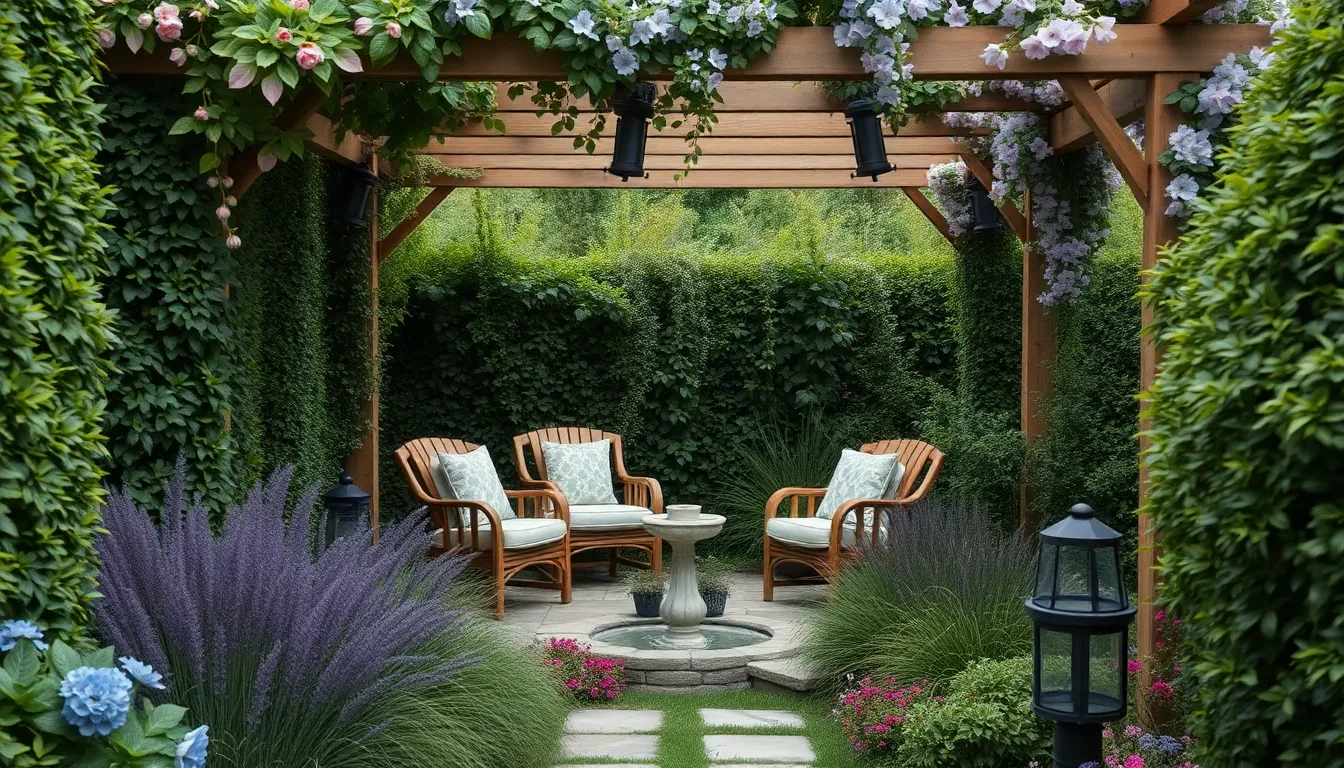
Secret garden rooms transform ordinary outdoor spaces into intimate retreats where we can escape daily pressures. Building on our minimalist design principles, these secluded areas offer privacy and tranquility within our larger garden industry.
Plant Fast-Growing Hedges for Natural Boundaries
Fast-growing hedges create natural boundaries that establish our secret garden room’s perimeter quickly and effectively. Buxus sempervirens (English boxwood) provides dense, evergreen screening that reaches 1-2 meters tall within 3-4 years of planting. We recommend spacing boxwood plants 30-40 cm apart for optimal coverage and growth.
Cupressus leylandii (Leylandii cypress) offers rapid vertical growth of up to 90 cm annually, making it ideal for urgent privacy needs. Plant these hedges 1 meter apart to achieve full screening within 2-3 years. Regular trimming maintains their shape and prevents overcrowding in smaller garden spaces.
Consider mixed hedge plantings using native species like hawthorn and blackthorn for wildlife-friendly boundaries. These thorny hedges provide excellent security while supporting local bird populations and pollinators throughout the growing season.
Add Garden Structures Like Pergolas and Arbors
Garden structures create architectural interest and support climbing plants that enhance our secret room’s vertical dimensions. Pergolas provide overhead screening using wooden or metal frameworks that support vigorous climbers like clematis and honeysuckle. Position pergolas to frame seating areas and create natural canopies for shade during summer months.
Arbors serve as elegant entrance points to our hidden garden rooms while supporting climbing roses and jasmine. Timber arbors blend naturally with cottage garden themes, while steel versions complement modern minimalist designs. Install arbors at pathway intersections to create dramatic transitions between garden zones.
Trellises and obelisks add vertical growing space without overwhelming smaller areas. Mount wooden trellises against boundary walls to support annual climbers like sweet peas and morning glories that provide seasonal color and fragrance.
Design Hidden Seating Areas and Quiet Corners
Hidden seating areas transform our secret garden rooms into functional outdoor living spaces where we can relax and entertain guests. Position benches and chairs in naturally sheltered spots surrounded by plants with varying textures like ornamental grasses, ferns, and flowering perennials.
Create visual interest using plants with cooler color palettes including blue hostas, silver artemisia, and purple lavender that produce calming atmospheres. Layer different plant heights to establish natural boundaries around seating without requiring formal structures or barriers.
Quiet corners benefit from strategic placement of water features like small fountains or bird baths that provide gentle sounds and attract wildlife. Incorporate fragrant plants such as rosemary, thyme, and mint near seating areas to engage multiple senses and enhance relaxation experiences.
Install subtle lighting using solar powered LED strips or lanterns to extend evening use of our secret garden rooms throughout the year.
Plan a Low-Maintenance Garden Perfect for Busy Lifestyles
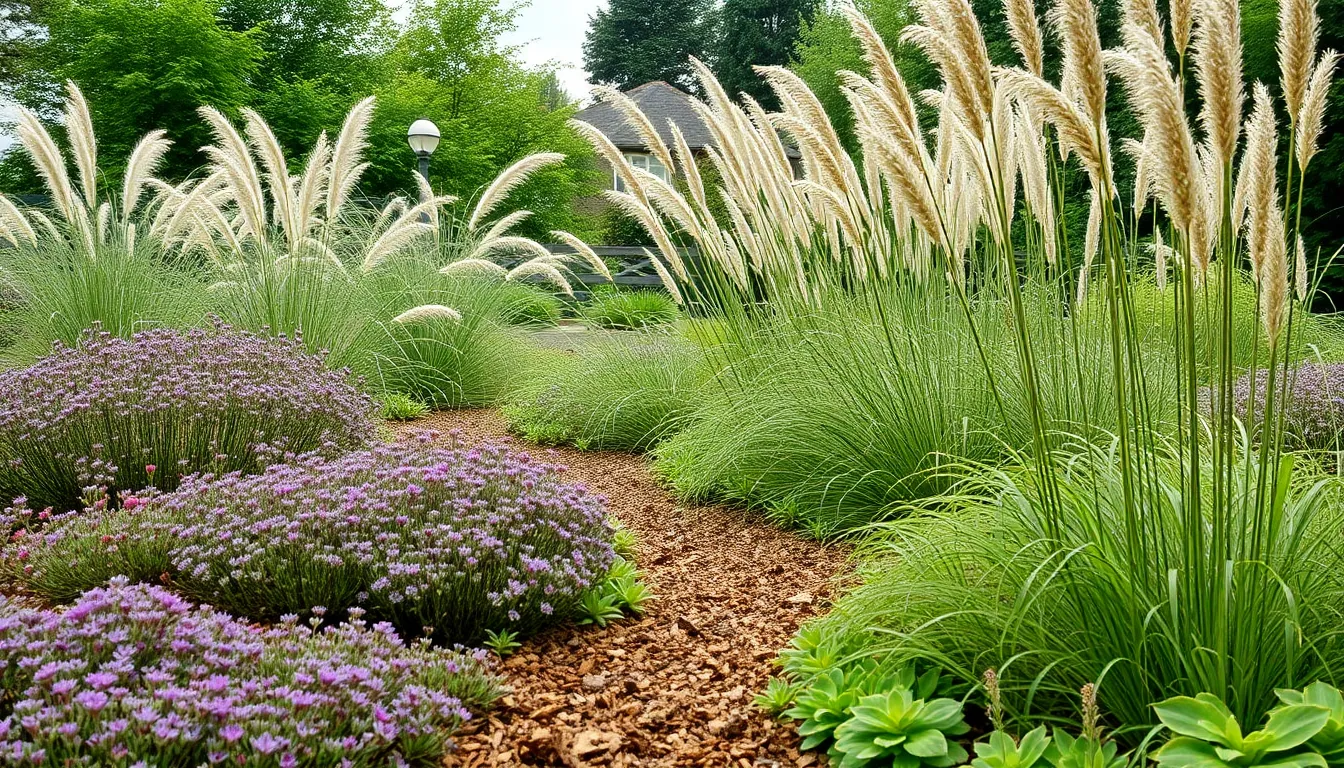
Creating a garden that thrives with minimal intervention allows us to enjoy outdoor beauty without sacrificing precious time. Smart plant choices and efficient maintenance strategies make it possible to achieve stunning results while accommodating demanding schedules.
Choose Drought-Tolerant Plants and Ground Covers
Selecting water-wise plants reduces our garden maintenance by up to 50% during hot summer months. Succulents like sedums and houseleeks thrive in UK conditions while requiring minimal irrigation throughout the growing season. These resilient plants store moisture in their thick leaves, making them perfect for busy gardeners who can’t water daily.
Ground covers such as creeping thyme and juniper create living carpets that naturally suppress weeds while adding fragrance and texture. Thyme releases aromatic oils when walked upon, transforming pathways into sensory experiences. These spreading plants eliminate the need for frequent weeding by blocking sunlight from reaching weed seeds below.
Ornamental grasses like feather reed grass and blue fescue provide year-round structure with virtually no maintenance requirements. Grasses naturally adapt to varying moisture levels and require cutting back just once annually in late winter.
Install Automatic Irrigation Systems
Automated watering systems eliminate daily garden tasks while ensuring consistent moisture delivery to plant roots. Timer-controlled drip irrigation provides precise water amounts directly to each plant’s base, reducing water waste by 30-50% compared to traditional sprinklers.
Smart irrigation controllers adjust watering schedules based on weather forecasts and soil moisture sensors. These advanced systems prevent overwatering during rainy periods while maintaining adequate hydration during dry spells. Connecting these systems to smartphone apps allows us to monitor and adjust settings remotely.
Soaker hoses offer budget-friendly automation for vegetable gardens and flower borders. Buried beneath mulch layers, these porous hoses deliver slow, steady moisture that penetrates deeply into soil rather than evaporating at the surface.
Use Mulching and Weed-Suppressing Techniques
Applying organic mulches like bark chippings reduces weeding time by 75% while retaining soil moisture for extended periods. Wood chips decompose gradually, enriching soil structure and feeding beneficial microorganisms that support plant health.
Gravel mulches provide permanent weed suppression around drought-tolerant plants and Mediterranean-style gardens. Stone mulches reflect heat upward to plant foliage while preventing moisture evaporation from soil surfaces below.
Industry fabric beneath decorative mulches creates an additional barrier against persistent weeds like dandelions and bindweed. Installing fabric properly requires overlapping edges by 6 inches and securing with industry pins every 3 feet for maximum effectiveness.
Raised beds filled with quality topsoil and compost reduce weed pressure from surrounding areas while improving drainage in heavy clay soils common throughout the UK. Building beds 30 cm deep provides optimal growing conditions that require less frequent soil amendments and pest management interventions.
Conclusion
Creating your perfect UK garden doesn’t have to feel overwhelming when you break it down into manageable styles and approaches. Whether you’re drawn to the romantic charm of cottage gardens or the sleek lines of modern minimalist designs there’s a solution that fits your space and lifestyle.
Remember that successful UK gardening starts with understanding your local conditions and choosing plants that thrive in our unique climate. From wildlife-friendly native species to productive kitchen gardens every approach we’ve explored offers its own rewards and beauty.
The key is starting with one area or style that speaks to you most then gradually expanding your vision. Your outdoor space can become the welcoming retreat you’ve always imagined with the right planning and plant choices customized to British growing conditions.
Frequently Asked Questions
What plants are best for a cottage garden in the UK?
Heritage roses like ‘Graham Thomas’ and ‘Gertrude Jekyll’ are excellent choices as they’re disease-resistant and provide continuous blooms. Combine these with mixed herbaceous borders for the signature layered cottage garden look. Climbing roses add vertical interest, while native UK plants ensure your garden thrives in local conditions.
How can I maximize space in a small urban garden?
Use vertical planters and living walls to utilize upward space effectively. Container gardening offers flexibility for rearrangements and seasonal changes. Create multi-level planting areas to add visual depth and increase growing space. Consider integrating seating and storage solutions to make the most of your limited outdoor area.
What makes a garden wildlife-friendly?
Plant native UK flowers and shrubs like holly and blackthorn to provide food and shelter for local wildlife. Install bird boxes and bee hotels to support local populations. Create natural ponds or water features for hydration sources. Use compost instead of chemical pesticides to maintain a healthy ecosystem.
How do I create a productive kitchen garden?
Design a four-quartered layout for effective crop rotation. Use raised beds with 30cm depth of quality topsoil enriched with organic materials. Focus on cool-weather crops like root vegetables, leafy greens, and legumes that thrive in the UK climate. Consider adding a greenhouse or cold frame to extend your growing season.
What are the best low-maintenance plants for busy gardeners?
Choose drought-tolerant plants like succulents and ground covers that require minimal watering and naturally suppress weeds. Ornamental grasses provide year-round structure with minimal care. Install automatic irrigation systems and use mulching techniques to reduce maintenance while retaining soil moisture and preventing weeds.
How can I create privacy in my garden?
Use fast-growing hedges like English boxwood and Leylandii cypress to establish natural boundaries. Install garden structures such as pergolas and arbors to enhance vertical dimensions while supporting climbing plants. Living walls and vertical planters also provide excellent privacy screens while maximizing growing space.
What should I consider for front garden design?
Use low-maintenance evergreen shrubs like box, yew, and hebes for year-round structure. Create defined pathways with natural materials such as stone and pebbles for better drainage and aesthetics. Add seasonal color through bulbs like tulips and daffodils, plus annuals like marigolds and petunias for continuous interest.
How do I design a modern minimalist garden?
Focus on architectural plants like ornamental grasses and bamboo for clean lines and visual interest. Incorporate contemporary materials such as steel and concrete to create geometric patterns. Use structured layouts with strategic lighting to enhance the minimalist aesthetic while maintaining functionality and tranquility.

